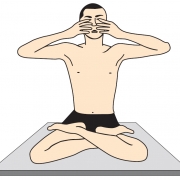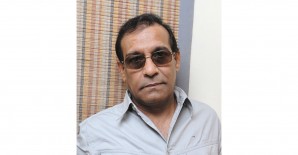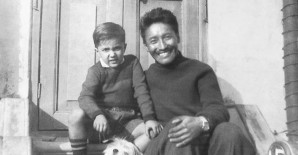
Columns

Shameem Akthar explores the link between singing bowl healing and yoga.
Singing bowl meditation and healing therapy is now enjoying a huge revival in the West and rewinding its way back to the lands of its origin. It is difficult to pin it down to any Asian country because all records show that music healing belongs to the entire Asian continent. However, the similarity of bowl therapy in the mountain belt establishes it as part of Himalayan tradition. The bowls contain in them the sounds of water, rain, thunder, wind and the deep howl of all these elements in the caverns and rocks of the mountains.
The connection to yoga is direct and dramatic. In all bowl traditions (Eastern and Western), the bowls contain the seven notes, with dominant notes linked to specific chakras. There are two dominant traditions—Vedic and Tibetan—with different connections of the notes to the chakras (somewhat like Eastern and Western star signs).
That said, most singing bowl therapies will have at least seven bowls. They will be placed to align with the chakra map. If single bowls are used, they will also be placed at or near the body part that requires healing.
The chakra connection with the bowl is deep, right from the seven metals used—from copper to gold. The placement of the bowls, either alongside or directly on top of the body part, is common to most traditions. There has been a recent spurt in crystal bowl therapy, with different gemstones used to create bowls. They too are chakra-related and the therapy is similar to the metal ones.
The connections not just with yoga but related sciences make bowl therapy an exciting, complementary practice. Aroma oils aligning with different chakras, as discussed in an earlier column (January 2016) of this series, and crystal therapy, with related crystals placed on the body of the practitioner (July 2016), or within the bowl, make it a happy, involved, healing movement.
Yogic moves
Closing seven gates (shanmukhi mudra)
Sit in a meditative posture. Close your eyes. Place hands on the face, as seen in the image. Shut your ears with your thumbs and press down on closed eyes with index fingers. Place each middle finger on either nostril. Let your ring and little finger remain above and below the closed lips respectively, on either side. Use the pressure of the middle finger to relax (when inhaling); press lightly, when retaining breath. Relax again when breathing out. Breathe in, retain, and exhale with awareness. Do a few times. After a while, focus on inner sounds you hear. Turn the mind inside. Often you start off by hearing the internal sounds of the body—breath, swallowing, etc. Keep the mind involuted, with awareness on the breath throughout. It is a recall of the anahat nada or unstuck sound—as with the bowls, it is not in the sounds but the vibrations shimmering between that you feel the magic. Do for a short while initially because the arms are likely to get tired. Later, increase duration. This mudra may be done during the hours of the day when outside sounds and distractions are less. Benefits: It heals the parts of the body above the neck, and most related ailments. It also teaches mental focus and stamina.
Nan yar? (Who am I?)
Teachings by Sri Ramana Maharishi
This is a small booklet. It is possibly not well-known among Indians but is part of the spiritual tradition of all seekers the world over. In this book are some of the most lucid explanations shared by sage Ramana Maharishi with his disciples in a simple Q&A format. He takes all the abstruse Advaita teachings and simplifies them, shorn of all the trappings that keep the terrific truth of yoga hidden from most of the world.
The question and answer goes somewhat like this:
Koham? (Who am I?) Na deham (Not this body). So ham So ham (I am That, I am That). I am not this body, not these thoughts, not these emotions, not this intellect. I am not in all these apparent things. I am beyond them. I am That.
It is a powerful and yet simple lesson. And among all the recent jnana yogis, Ramana is the most lucid. He talks in short sentences, clearly dealing with the immediate essence of the question and giving an answer that appeals not just to the intellect but our common sense. With him, jnana yoga (yoga of the intellect) leaves its ivory tower and walks with the seeker. This is a must-read for anybody struggling with spiritual questions of yoga. Here is another sample quote from this booklet, available free online:
Q: How will the mind become quiescent?
A: By the inquiry ‘Who am I?’. The thought ‘who am I?’ will destroy all other thoughts, and like the stick used for stirring the burning pyre, it will itself in the end get destroyed. Then, there will arise self-realisation.
Shameem Akthar is a Mumbai-based yoga acharya. If you have any queries for her, mail us or email at contact.us@harmonyindia.org. (Please consult your physician before following the advice given here)
Photograph by iStock Featured in Harmony — Celebrate Age Magazine October 2016
you may also like to read
-
Mental workout
Mukul Sharma tells you how to keep those grey cells ticking Everyone will ultimately lose his or her brain….
-
Helpline
Dr Harshbir Rana answers your queries on personal and social issues related to ageing, elder care and intergenerational relationships ….
-
Off the cuff
Raju Mukherji pays tribute to his first hero, Tenzing Norgay, an exemplary mountaineer Darjeeling, 1955. Dr ‘Pahari’ Guha Mazumdar….
-
Yoga RX
Shameem Akthar shows ways to control debilitating ankle pain through regular practice Ankle pain is so common and prevalent….








